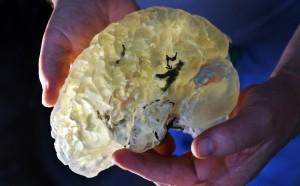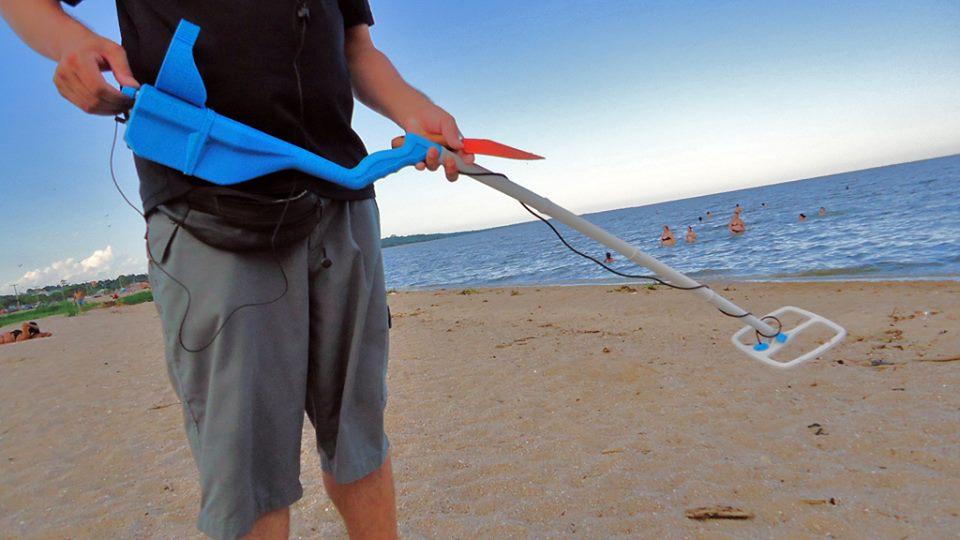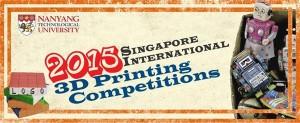This week’s news stories we didn’t have time to cover run the spectrum of 3D printing heavy-hitters, from top industry leaders to the desktop geniuses who populate the 3D printing space. While industry leaders seek to cut production time and improve performance using innovative approaches, exceptional designs and 3D prints also emerge from diverse places and aspire to make great contributions that can also change lives (and make a little cash on the side, too).
Laser printing DNA for cheap tops the list of more outlandish advances, while we also saw more practical printed brain replicas, robots, racetracks, metal detectors, and new PLA filament to remind us of the creative spirit that drives 3D printing. Two other developments this week recognize exactly this spirit: the beginning of Science Channel’s new “All-American Makers” show and Singapore’s Centre for 3D Printing’s 2015 Competition, which wants to give you cash awards for your innovations in “Vintage Toys” and “Center Logo Design” categories. While industry giants speed up, makers (and doctors) are digging in and coming up with some great new 3D printed creations.
Boston Children’s Hospital Uses 3D Printed Models
We begin with uplifting medical news, as Boston Children’s Hospital has entered the 3D printing medical scene, and recently used one of their own 3D printers to aid a brain surgeon in a complex surgery to remove more than one ounce of a 16-year-old teen’s brain tissue. Boston Children’s Hospital has printed more than 170 models of blood vessels, rib cages, skulls, spines, and in this case, brains. (It has one Stratasys printer that runs there ’round the clock to aid medical teams.) The models help the surgeons practice surgeries before the real thing and can be used to explain the procedures to loved ones. Boston Children’s Hospital reportedly will spend over $1.2 million on 3D printing related activities by the end of the year, and it also plans to study the effects that 3D printing can have on the medical field.
cages, skulls, spines, and in this case, brains. (It has one Stratasys printer that runs there ’round the clock to aid medical teams.) The models help the surgeons practice surgeries before the real thing and can be used to explain the procedures to loved ones. Boston Children’s Hospital reportedly will spend over $1.2 million on 3D printing related activities by the end of the year, and it also plans to study the effects that 3D printing can have on the medical field.
Unilever Uses Stratasys 3D Printer and Cuts Production Time by 40%
Speaking of Stratasys 3D printers, Unilever has recently announced that by using Stratasys’ PolyJet 3D printing technology to manufacture its consumer goods, the company — which owns Dove, Lipton, Ben & Jerry’s, Axe, Vaseline, Surf, Domestos, Hellman’s, and Comfort brands to name a few — can cut by 40% its lead times for prototyping  parts. The company’s division in Italy uses Stratasys’ Objet500 Connex for household/laundry products. It prints injection molded tools for items such as toilet rim blocks, bottle caps, and closures.
parts. The company’s division in Italy uses Stratasys’ Objet500 Connex for household/laundry products. It prints injection molded tools for items such as toilet rim blocks, bottle caps, and closures.
Unilever uses strong Digital ABS material for 3D printing. It also uses an FDM-based Fortus 360mc 3D Production System, using ABS-M30 production-grade plastic, to print thermoforming, flexible mold prototypes that can endure product testing. So next time you buy a bottle of Surf detergent, a jar of Hellman’s mayonnaise, or one of those toilet cleaners you hang inside the toilet rim, just remember that 3D printing may have played a role in the making of that product!
3DSIM and Additive Industries Partner to Save Time and Money in 3D Printing
Like in any business, and as Unilever’s own experience has shown us, time is money in 3D printing/additive manufacturing. And money can be lost when prints go wrong. Louisville’s 3DSIM has developed software that Netherlands-based Additive Industries plans to use. This software optimizes metal 3D printing processing simulation tools based on the actual geometry, material properties, machine behaviors, and process parameters of additive manufacturing protocols. 3DSIM software claims the time required to simulate a 3D printing problem can be cut drastically. There’s no doubt that the 3D printing space can use an improved simulation model, and this symbiotic collaboration between software designers and manufacturing may provide great improvements that can benefit the entire industry eventually.
Cheap Printable DNA Gets Major Funding Boost
In other 3D printing business news, San Francisco-based start-up Cambrian Genomics has received $10 million in funding to realize their science fiction vision of making 3D printable DNA an affordable consumer item. Making DNA and selling it will be easier for the company now that they challenge the expenses involved. C reating one set of human chromosomes by traditional printing methods can cost billions of dollars, but Cambrian Genomics uses laser printers to sort DNA strands (the costly time consuming requirement). Lasers aid the sorting process, significantly cutting down time, rendering the 3D printing of DNA more of a household activity where anyone can be a genetic designer. Forget mice with human ears attached, people. CEO Austen Heinz is talking 3D printing dinosaurs. Stay tuned.
reating one set of human chromosomes by traditional printing methods can cost billions of dollars, but Cambrian Genomics uses laser printers to sort DNA strands (the costly time consuming requirement). Lasers aid the sorting process, significantly cutting down time, rendering the 3D printing of DNA more of a household activity where anyone can be a genetic designer. Forget mice with human ears attached, people. CEO Austen Heinz is talking 3D printing dinosaurs. Stay tuned.
Dad 3D Prints Hot Wheels Racetrack Parts for Son, and Himself
While little children dream of dinosaurs, they also dream of traintracks and racetracks in almost equal measure. Far less ambitious than the 3D printing of dinosaurs, but nonetheless impressive, an electrician father has designed and 3D printed a Hot Wheels racetrack for his 3-year-old son. Using a desktop 3D printer, he printed almost all of the parts for this racetrack except the track itself (he used Blu Track for that).
Man 3D Prints Functional Robotic Arm
Robots also top the list of the stuff that younger children’s (and older kids-at-hearts’) dreams are made of. Andreas Hölldorfer wanted to 3D print his dream of a functional robot arm and this is exactly what he did. On his blog and in various YouTube clips, he shows how he made the arm, which consists of several joints and a gripper. He 3D printed all of this on his Delta 3D printer in about a week using more than 1.2 kg of ABS. He designed and printed using the slic3r honeycomb infill at about 12%. The design of the robot arm can probably be accommodated by most 3D printers, but be warned: the printing and assembly process is quite complicated, so you may want to read all of his directions carefully before you try this at home.
Hölldorfer is also working on an ongoing project to develop a 3D printed, multi-limbed gripping robot arm on a rotary plate. This robot can move in all directions and is user-controlled. It’s a plastic industrial robot capable of holding a cup of coffee — and of course, much more in due time.
Beach Metal Detector is 3D Printed
Another functional device that has been 3D printed is your handy beach metal detector. Paulo Bubolz has 3D printed the entire body, handle, pole, and coil enclosure of a detector that has been assembled and tested as a working prototype. It took him three prototype attempts to get the now ergonomically correct handle right, and Bubolz states that the  hardest part of the project was the design’s electronics and battery pack. After trying out various options, he 3D printed the enclosure in two parts that are screwed together; this makes the box easier to print and makes the electronics more accessible. He also 3D printed an arm brace, three knobs used to control the device, and made sure to model openings for a battery charger and even a headphone jack! The detector’s rod portion is made from four smaller pieces that are easily assembled with screws. This easy assembly makes the device easy to transport, and it appears from the little treasures Bubolz found in his test run of the detector — it works!
hardest part of the project was the design’s electronics and battery pack. After trying out various options, he 3D printed the enclosure in two parts that are screwed together; this makes the box easier to print and makes the electronics more accessible. He also 3D printed an arm brace, three knobs used to control the device, and made sure to model openings for a battery charger and even a headphone jack! The detector’s rod portion is made from four smaller pieces that are easily assembled with screws. This easy assembly makes the device easy to transport, and it appears from the little treasures Bubolz found in his test run of the detector — it works!
Singapore International 3D Printing Competitions’ Categories Announced
Nanyang Technology University announces two categories in its annual Singapore Centre for 3D Printing (SC3DP) Competitions. This year features Vintage Toys and Logo Design competitions. The Vintage Toys  competition encourages makers to get inspired by toy designs of bygone eras. Here they are looking for the “unique cultural and historic significance of the toys” while also injecting them with cutting edge engineering elements. For the Logo Design competition, participants are invited to submit “innovative and futuristic functional logo designs” that capture the spirit of this $113 million research center’s mission to be the “world’s leading 3D printing research institute.”
competition encourages makers to get inspired by toy designs of bygone eras. Here they are looking for the “unique cultural and historic significance of the toys” while also injecting them with cutting edge engineering elements. For the Logo Design competition, participants are invited to submit “innovative and futuristic functional logo designs” that capture the spirit of this $113 million research center’s mission to be the “world’s leading 3D printing research institute.”
The top prize is $10,000 in the open division competition. There’s also a $5,000 prize in the elementary-high school student division, and a $5,000 prize in the polytechnics and university student division. Your last day to submit entries is April 24, 2015, so get started on your vintage toy and logo design ideas today!
Science Channel’s “All-American Makers” Premiered This Week
Makers! Your  “American Idol” has arrived. If cash prizes haven’t inspired the maker in you yet through the SC3DP competition, perhaps you can get your creative juices flowing again by taking in Discovery Science Channel’s latest series, “All-American Maker.” Every week makers compete for the attention of the judges — Printbot’s Brook Drumm, mechanical whiz Brian Roe, and venture funder Marc Portney– in order to get the funding needed to realize their inventions. The six episodes that have been filmed so far leave no stone unturned, covering: robots, hybrid vehicles, thermal radar, dog toys, and stain repellant. The show airs Wednesday nights on the Science Channel.
“American Idol” has arrived. If cash prizes haven’t inspired the maker in you yet through the SC3DP competition, perhaps you can get your creative juices flowing again by taking in Discovery Science Channel’s latest series, “All-American Maker.” Every week makers compete for the attention of the judges — Printbot’s Brook Drumm, mechanical whiz Brian Roe, and venture funder Marc Portney– in order to get the funding needed to realize their inventions. The six episodes that have been filmed so far leave no stone unturned, covering: robots, hybrid vehicles, thermal radar, dog toys, and stain repellant. The show airs Wednesday nights on the Science Channel.
German RepRap Announces New Performance PLA Filament
For some reason, I am always compelled to end our weekly reviews by covering filament. I think it is because it’s such a behind-the-scenes but elemental aspect of 3D printing. It’s the substance of the printing: and it’s what is usually  developing without great fanfare. Well, this week German RepRap introduced its optically smooth PLA filament designed specifically for 3D printing. The Performance PLA is available in 2.1 kg (3 mm) and 750 g (1.75 mm) spools from German RepRap international sales partners. The filament requires a lower heating temperature that guarantees less warping and better adhesion, and it has a smoother surface.
developing without great fanfare. Well, this week German RepRap introduced its optically smooth PLA filament designed specifically for 3D printing. The Performance PLA is available in 2.1 kg (3 mm) and 750 g (1.75 mm) spools from German RepRap international sales partners. The filament requires a lower heating temperature that guarantees less warping and better adhesion, and it has a smoother surface.
That’s this week’s stories we didn’t cover: the entrepreneurial spirit lives on in 3D printing, and it looks like more makers have opportunities to get rewarded for their hard work and inventive worldviews. Let us know what you think about these developments in the Stories We Missed forum thread over at 3DPB.com.
Subscribe to Our Email Newsletter
Stay up-to-date on all the latest news from the 3D printing industry and receive information and offers from third party vendors.
You May Also Like
Meltio Expands Global Reach with New Partnerships in the Americas and Europe
Spanish 3D printing manufacturer Meltio has expanded its sales network across the globe. With the addition of three new partners in the United States, Brazil, Argentina, and Italy, Meltio aims...
3D Printing Webinar and Event Roundup: April 7, 2024
Webinars and events in the 3D printing industry are picking back up this week! Sea-Air-Space is coming to Maryland, and SAE International is sponsoring a 3D Systems webinar about 3D...
On the Ground in Linares, Spain for the Meltio M600 Launch
As detailed in a previous post, metal 3D printer manufacturer Meltio launched its latest wire-laser metal deposition (LMD) machine, the Meltio M600, at its headquarters in Linares, Spain. There, I was...
Blue Laser-powered M600 3D Printer Launched by Meltio
Founded in 2019 as a joint venture between Additec and Sicnova, metal 3D printer OEM Meltio develops and manufactures high-performance and easy-to-use metal 3D printing solutions that use its patented wire-laser metal...































